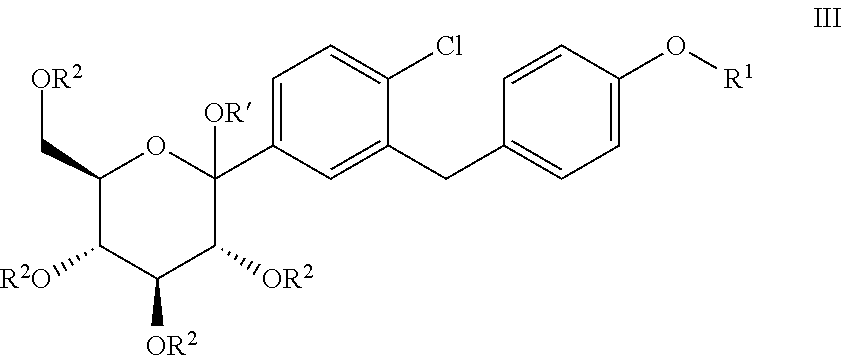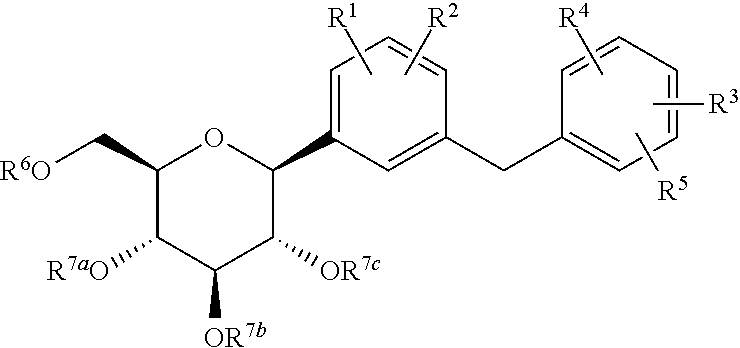Processes for preparing of glucopyranosyl-substituted benzyl-benzene derivatives
a technology of benzylbenzene and glucopyranosyl, which is applied in the field of process for preparing glucopyranosylsubstituted benzylbenzene derivatives, to achieve the effects of reducing the length of the whole process, high yield and high purity
- Summary
- Abstract
- Description
- Claims
- Application Information
AI Technical Summary
Benefits of technology
Problems solved by technology
Method used
Image
Examples
example 1
Synthesis of the fluoride VIII.1
[0067]Oxalylchloride (176 kg; 1386 mol; 1.14 eq) is added to a mixture of 2-chloro-5-iodo benzoic acid (343 kg; 1214 mol) (compound IX.1), fluorobenzene (858 kg) and N,N-dimethylformamide (2 kg) within 3 hours at a temperature in the range from about 25 to 30° C. (gas formation). After completion of the addition, the reaction mixture is stirred for additional 2 hours at a temperature of about 25 to 30° C. The solvent (291 kg) is distilled off at a temperature between 40 and 45° C. (p=200 mbar). Then the reaction solution (911 kg) is added to aluminiumchloride AlCl3 (181 kg) and fluorobenzene (192 kg) at a temperature between about 25 and 30° C. within 2 hours. The reaction solution is stirred at the same temperature for about an additional hour. Then the reaction mixture is added to an amount of 570 kg of water within about 2 hours at a temperature between about 20 and 30° C. and stirred for an additional hour. After phase separation the organic phase...
example 2
Synthesis of the ketone VII.1
[0068]To a solution of the fluoride VIII.1 (208 kg), tetrahydrofuran (407 kg) and (S)-3-hydroxytetrahydrofuran (56 kg) is added potassium-tert-butanolate solution (20%) in tetrahydrofuran (388 kg) within 3 hrs at 16 to 25° C. temperature. After completion of the addition, the mixture is stirred for 60 min at 20° C. temperature. Then the conversion is determined via HPLC analysis. Water (355 kg) is added within 20 min at a temperature of 21° C. (aqueous quench). The reaction mixture is stirred for 30 min (temperature: 20° C.). The stirrer is switched off and the mixture is left stand for 60 min (temperature: 20° C.). The phases are separated and solvent is distilled off from the organic phase at 19 to 45° C. temperature under reduced pressure. 2-Propanol (703 kg) is added to the residue at 40 to 46° C. temperature and solvent is distilled off at 41 to 50° C. temperature under reduced pressure. 2-Propanol (162 kg) is added to the residue at 47° C. temperat...
example 3
Synthesis of the iodide V.1
[0069]To a solution of ketone VII.1 (217.4 kg) and aluminium chloride (AlCl3; 81.5 kg) in toluene (366.8 kg) is added 1,1,3,3-tetramethyldisiloxane (TMDS, 82.5 kg) within 1 hr 30 min (temperature: 18-26° C.). After completion of the addition, the mixture is stirred for additional 1 hr at a temperature of 24° C. Then the conversion is determined via HPLC analysis. Subsequently the reaction mixture is treated with acetone (15.0 kg), stirred for 1 hr 5 min at 27° C. temperature and the residual TMDS content is analyzed via GC. Then a mixture of water (573 kg) and concentrated HCl (34 kg) is added to the reaction mixture at a temperature of 20 to 51° C. (aqueous quench). The reaction mixture is stirred for 30 min (temperature: 51° C.). The stirrer is switched off and the mixture is left stand for 20 min (temperature: 52° C.). The phases are separated and solvent is distilled off from the organic phase at 53-73° C. temperature under reduced pressure. Toluene (5...
PUM
| Property | Measurement | Unit |
|---|---|---|
| temperature | aaaaa | aaaaa |
| temperature | aaaaa | aaaaa |
| temperature | aaaaa | aaaaa |
Abstract
Description
Claims
Application Information
 Login to View More
Login to View More - R&D
- Intellectual Property
- Life Sciences
- Materials
- Tech Scout
- Unparalleled Data Quality
- Higher Quality Content
- 60% Fewer Hallucinations
Browse by: Latest US Patents, China's latest patents, Technical Efficacy Thesaurus, Application Domain, Technology Topic, Popular Technical Reports.
© 2025 PatSnap. All rights reserved.Legal|Privacy policy|Modern Slavery Act Transparency Statement|Sitemap|About US| Contact US: help@patsnap.com



